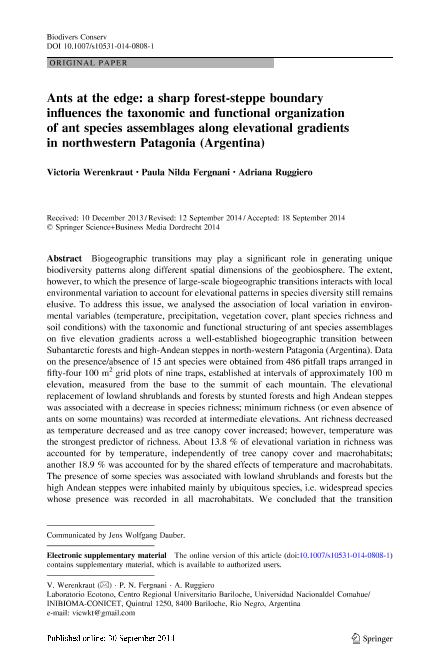Mostrar el registro sencillo del ítem
dc.contributor.author
Ruggiero, Adriana

dc.contributor.author
Werenkraut, Victoria

dc.contributor.author
Fergnani, Paula Nilda

dc.date.available
2017-01-19T20:22:29Z
dc.date.issued
2014-09
dc.identifier.citation
Ruggiero, Adriana; Werenkraut, Victoria; Fergnani, Paula Nilda; Ants at the edge: a sharp forest-steppe boundary influences the taxonomic and functional organization of ant species assemblages along elevational gradients in northwestern Patagonia (Argentina); Springer; Biodiversity And Conservation; 24; 2; 9-2014; 287-308
dc.identifier.issn
0960-3115
dc.identifier.uri
http://hdl.handle.net/11336/11657
dc.description.abstract
Biogeographic transitions may play a significant role in generating unique
biodiversity patterns along different spatial dimensions of the geobiosphere. The extent, however, to which the presence of large-scale biogeographic transitions interacts with local environmental variation to account for elevational patterns in species diversity still remains
elusive. To address this issue, we analysed the association of local variation in environmental variables (temperature, precipitation, vegetation cover, plant species richness and soil conditions) with the taxonomic and functional structuring of ant species assemblages on five elevation gradients across a well-established biogeographic transition between Subantarctic forests and high-Andean steppes in north-western Patagonia (Argentina). Data on the presence/absence of 15 ant species were obtained from 486 pitfall traps arranged in fifty-four 100 m2 grid plots of nine traps, established at intervals of approximately 100 m elevation, measured from the base to the summit of each mountain. The elevational replacement of lowland shrublands and forests by stunted forests and high Andean steppes was associated with a decrease in species richness; minimum richness (or even absence of ants on some mountains) was recorded at intermediate elevations. Ant richness decreased as temperature decreased and as tree canopy cover increased; however, temperature was
the strongest predictor of richness. About 13.8 % of elevational variation in richness was accounted for by temperature, independently of tree canopy cover and macrohabitats; another 18.9 % was accounted for by the shared effects of temperature and macrohabitats. The presence of some species was associated with lowland shrublands and forests but the high Andean steppes were inhabited mainly by ubiquitous species, i.e. widespread species whose presence was recorded in all macrohabitats. We concluded that the transition between the Subantarctic forests and high Andean steppes represents a sharp barrier to ant
species? elevational distribution. This, in association with elevational variation in continuous environmental functions, mainly temperature, influences the richness and taxonomic and functional structuring of ant species assemblages at temperate latitudes of the southern hemisphere.
dc.format
application/pdf
dc.language.iso
eng
dc.publisher
Springer

dc.rights
info:eu-repo/semantics/openAccess
dc.rights.uri
https://creativecommons.org/licenses/by-nc-sa/2.5/ar/
dc.subject
Biogeographical Transition
dc.subject
Formicidae
dc.subject
Functional Diversity
dc.subject
Indicator Species
dc.subject.classification
Zoología, Ornitología, Entomología, Etología

dc.subject.classification
Ciencias Biológicas

dc.subject.classification
CIENCIAS NATURALES Y EXACTAS

dc.title
Ants at the edge: a sharp forest-steppe boundary influences the taxonomic and functional organization of ant species assemblages along elevational gradients in northwestern Patagonia (Argentina)
dc.type
info:eu-repo/semantics/article
dc.type
info:ar-repo/semantics/artículo
dc.type
info:eu-repo/semantics/publishedVersion
dc.date.updated
2016-12-12T14:20:31Z
dc.journal.volume
24
dc.journal.number
2
dc.journal.pagination
287-308
dc.journal.pais
Alemania

dc.journal.ciudad
Berlin
dc.description.fil
Fil: Ruggiero, Adriana. Consejo Nacional de Investigaciones Científicas y Técnicas. Centro Científico Tecnológico Patagonia Norte. Instituto de Investigación En Biodiversidad y Medioambiente; Argentina. Universidad Nacional del Comahue; Argentina
dc.description.fil
Fil: Werenkraut, Victoria. Consejo Nacional de Investigaciones Científicas y Técnicas. Centro Científico Tecnológico Patagonia Norte. Instituto de Investigación En Biodiversidad y Medioambiente; Argentina. Universidad Nacional del Comahue; Argentina
dc.description.fil
Fil: Fergnani, Paula Nilda. Consejo Nacional de Investigaciones Científicas y Técnicas. Centro Científico Tecnológico Patagonia Norte. Instituto de Investigación En Biodiversidad y Medioambiente; Argentina. Universidad Nacional del Comahue; Argentina
dc.journal.title
Biodiversity And Conservation

dc.relation.alternativeid
info:eu-repo/semantics/altIdentifier/url/http://link.springer.com/article/10.1007/s10531-014-0808-1
dc.relation.alternativeid
info:eu-repo/semantics/altIdentifier/url/http://dx.doi.org/10.1007/s10531-014-0808-1
Archivos asociados
